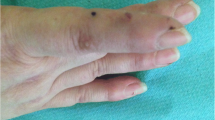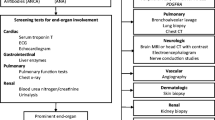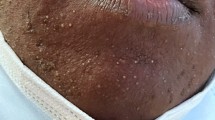Abstract
Eosinophilia is an uncommon manifestation in Rheumatoid arthritis (RA), and there is a paucity of data regarding the relationship of eosinophilia with disease-related factors. We prospectively evaluated the clinical and disease-specific characteristics of RA patients with eosinophilia. Consecutive patients with RA with an absolute eosinophil count ≥ 500/mm3 without an apparent cause for eosinophilia, were investigated for parasitic infestation. Patients with a definite parasitic infestation received targeted therapy, and the rest were treated with albendazole empirically. The RA disease-specific characteristics of the patients with persistent eosinophilia were compared with the patients without eosinophilia. Of the 160 patients with eosinophilia, 30 patients (19%) had allergic diseases, six patients had bronchiectasis, and one patient had hypereosinophilia of undetermined significance. Intestinal helminthiasis was found in 34 patients (21%). Eosinophilia was unexplained in 89 patients (56%) and it resolved after empirical albendazole therapy in about two-thirds (58 patients). Thirty-one patients had persistent eosinophilia. Nonsteroidal anti-inflammatory drug and disease-modifying antirheumatic drug modification did not show any effect on eosinophilia. The disease-related characteristics were similar between patients with persistent eosinophilia and those without eosinophilia. Eosinophilia is due to secondary causes in the majority of RA patients, and the most common cause in our setting is an intestinal helminthic infection. Persistent eosinophilia in our cohort of RA did not indicate a more severe disease phenotype.

Similar content being viewed by others
Abbreviations
- ACPA:
-
Anti-citrullinated protein antibodies
- AEC:
-
Absolute eosinophil count
- ALT:
-
Alanine aminotransferase
- AST:
-
Aspartate aminotransferase
- DAS28:
-
Disease activity score in 28 joints
- DMARDs:
-
Disease-modifying antirheumatic drugs
- DRESS:
-
Drug rash with eosinophilia and systemic symptoms
- ELISA:
-
Enzyme-linked immunosorbent assay
- ESPOIR:
-
Etude et Suivi des POlyarthrites Indifférenciées Récentes
- ESR:
-
Erythrocyte sedimentation rate
- FIP1L1-PDGFRA (F/P):
-
Fip1-like 1-platelet-derived growth factor receptor alpha fusion gene
- HCQ:
-
Hydroxychloroquine
- HEus:
-
Hypereosinophilia of undetermined significance
- IHAQ:
-
Indian version of the Health Assessment Questionnaire
- ILD:
-
Interstitial lung disease
- LEF:
-
Leflunomide
- MTX:
-
Methotrexate
- NSAIDs:
-
Nonsteroidal anti-inflammatory drugs
- PDGFRB:
-
Platelet-derived growth factor receptor beta
- RA:
-
Rheumatoid arthritis
- RF:
-
Rheumatoid factor
- SJ:
-
Swollen joint
- SSZ:
-
Sulfasalazine
- TJ:
-
Tender joint
- VAS:
-
Visual analog scale
References
Tamaki H, Chatterjee S, Langford CA (2015) Eosinophilia in rheumatologic/vascular disorders. Immunol Allergy Clin N Am 35:453–476. https://doi.org/10.1016/j.iac.2015.05.001
Chiardola F, Schneeberger EE, Citera G et al (2008) Prevalence and clinical significance of eosinophilia in patients with rheumatoid arthritis in Argentina. J Clin Rheumatol 14:211–213. https://doi.org/10.1097/RHU.0b013e31817738ce
Guellec D, Milin M, Cornec D et al (2015) Eosinophilia predicts poor clinical outcomes in recent-onset arthritis: results from the ESPOIR cohort. RMD Open 1:e000070. https://doi.org/10.1136/rmdopen-2015-000070
Sofi F, Parrey A, Ahmad M (2016) Eosinophilia in rheumatoid arthritis patients and its relation to disease activity: a single center experience from Kashmir, India. Egypt Rheumatol. https://doi.org/10.1016/j.ejr.2016.10.002
Kang G, Mathew MS, Rajan DP et al (1998) Prevalence of intestinal parasites in rural Southern Indians. Trop Med Int Heal 3:70–75
Kaliappan SP, George S, Francis MR et al (2013) Prevalence and clustering of soil-transmitted helminth infections in a tribal area in southern India. Trop Med Int Heal 18:1452–1462. https://doi.org/10.1111/tmi.12205
Dhanabal J, Selvadoss PP, Muthuswamy K (2014) Comparative study of the prevalence of intestinal parasites in low socioeconomic areas from South chennai, India. J Parasitol Res 2014:630968. https://doi.org/10.1155/2014/630968
Doran MF, Crowson CS, Pond GR et al (2002) Frequency of infection in patients with rheumatoid arthritis compared with controls: a population-based study. Arthritis Rheum 46:2287–2293. https://doi.org/10.1002/art.10524
Doran MF, Crowson CS, Pond GR et al (2002) Predictors of infection in rheumatoid arthritis. Arthritis Rheum 46:2294–2300. https://doi.org/10.1002/art.10529
Greenberg JD, Reed G, Kremer JM et al (2010) Association of methotrexate and tumour necrosis factor antagonists with risk of infectious outcomes including opportunistic infections in the CORRONA registry. Ann Rheum Dis 69:380–386. https://doi.org/10.1136/ard.2008.089276
Savolainen HA, Leirisalo-Repo M (2001) Eosinophilia as a side-effect of methotrexate in patients with chronic arthritis. Clin Rheumatol 20:432–434
Michel F, Navellou J-C, Ferraud D et al (2005) DRESS syndrome in a patient on sulfasalazine for rheumatoid arthritis. Jt Bone Spine 72:82–85. https://doi.org/10.1016/j.jbspin.2004.06.002
Malisiewicz B, Murer C, Pachlopnik Schmid J et al (2011) Eosinophilia during psoriasis treatment with TNF antagonists. Dermatology 223:311–315. https://doi.org/10.1159/000334805
Pinto B, Dhir V, Krishnan S, Nada R (2013) Leflunomide-induced DRESS syndrome with renal involvement and vasculitis. Clin Rheumatol 32:689–693. https://doi.org/10.1007/s10067-012-2152-8
Morrisroe K, Wong M (2015) Drug-induced hypereosinophilia related to tocilizumab therapy for rheumatoid arthritis. Rheumatol 54:2113–2114. https://doi.org/10.1093/rheumatology/kev275
Winchester RJ, Koffler D, Litwin SD, Kunkel HG (1971) Observations on the eosinophilia of certain patients with rheumatoid arthritis. Arthritis Rheum 14:650–665
Panush RS, Franco AE, Schur PH (1971) Rheumatoid arthritis associated with eosinophilia. Ann Intern Med 75:199–205
Aletaha D, Neogi T, Silman AJ et al (2010) 2010 Rheumatoid arthritis classification criteria: an American College of Rheumatology/European League Against Rheumatism collaborative initiative. Arthritis Rheum 62:2569–2581. https://doi.org/10.1002/art.27584
Kumar A, Malaviya AN, Pandhi A, Singh R (2002) Validation of an Indian version of the Health Assessment Questionnaire in patients with rheumatoid arthritis. Rheumatology 41:1457–1459
Yogendra V, An R, Shariff S (2011) Blood and tissue eosinophilia: a study at the MVJ Medical College and Research Hospital with Review of Literature. RGUHS J Med Sci 1:4–13
Bansal R, Kaur A, Suri AK et al (2017) Incidence of eosinophilia in rural population in North India: a study at Tertiary Care Hospital. Ann Pathol Lab Med 4:0–4. https://doi.org/10.21276/apalm.2017.1044
Chammartin F, Scholte RGC, Guimarães LH et al (2013) Soil-transmitted helminth infection in South America: a systematic review and geostatistical meta-analysis. Lancet Infect Dis 13:507–518. https://doi.org/10.1016/S1473-3099(13)70071-9
Karsh J, Chen Y, Lin M, Dales R (2005) The association between allergy and rheumatoid arthritis in the Canadian population. Eur J Epidemiol 20:783–787. https://doi.org/10.1007/s10654-005-0704-9
Dougados M, Soubrier M, Antunez A et al (2013) Prevalence of comorbidities in rheumatoid arthritis and evaluation of their monitoring: results of an international, cross-sectional study (COMORA). Ann Rheum Dis 73:62–68. https://doi.org/10.1136/annrheumdis-2013-204223
Lai NS, Tsai TY, Koo M, Lu MC (2015) Association of rheumatoid arthritis with allergic diseases: a nationwide population-based cohort study. Allergy Asthma Proc 36:99–103. https://doi.org/10.2500/aap.2015.36.3871
Boissier MC, Semerano L, Challal S et al (2012) Rheumatoid arthritis: from autoimmunity to synovitis and joint destruction. J Autoimmun 39:222–228. https://doi.org/10.1016/j.jaut.2012.05.021
Mishra A, Yao X, Levine SJ (2013) From bedside to bench to clinic trials: identifying new treatments for severe asthma. Dis Model Mech 6:877–888. https://doi.org/10.1242/dmm.012070
Simpson CR, Anderson WJA, Helms PJ et al (2002) Coincidence of immune-mediated diseases driven by TH1 and TH2 subsets suggests a common aetiology. A population-based study using computerized General Practice data. Clin Exp Allergy 32:37–42. https://doi.org/10.1046/j.0022-0477.2001.01250.x
Moore TA, Nutman TB (1998) Eosinophilia in the returning traveler. Infect Dis Clin N Am 12:503–521
Curtis C, Ogbogu PU (2015) Evaluation and differential diagnosis of persistent marked eosinophilia. Immunol Allergy Clin N Am 35:387–402. https://doi.org/10.1016/j.iac.2015.04.001
Roufosse F, Weller PF (2010) Practical approach to the patient with hypereosinophilia. J Allergy Clin Immunol 126:39–44. https://doi.org/10.1016/j.jaci.2010.04.011
Smolen JS (2016) Treat-to-target as an approach in inflammatory arthritis. Curr Opin Rheumatol 28:297–302. https://doi.org/10.1097/BOR.0000000000000284
Misra DP, Sharma A, Agarwal V (2018) Rheumatology science and practice in India. Rheumatol Int 38:1587–1600. https://doi.org/10.1007/s00296-018-4111-4
Acknowledgements
The authors thank Dr. Nonika Rajkumari, Assistant Professor, Department of Microbiology, JIPMER, for her contributions in parasitic work up.
Funding
The research was funded by an intramural research grant, Jawaharlal Institute of Postgraduate Medical Education and Research, Puducherry, India. (Grant no.: JIP/Res/Intra-DM-M.Ch/01/2015-16 and JIP/Res/Intra-DM, M.Ch/phas1/grant2/01/2016-17).
Author information
Authors and Affiliations
Contributions
(1) The conception and design of the study—DE, SCP, RK, and VSN. Acquisition of data—DE, SCP, AJ, and DPM. Analysis and interpretation of data—DE, SCP, AJ, and DPM. (2) Drafting the article—DE, AJ, and DPM. Revising it critically for important intellectual content—SCP, RK, and VSN. (3) Final approval of the version to be submitted—DE, SCP, AJ, DPM, RK, and VSN. (4) Agreement to be accountable for all aspects of the work in ensuring that questions related to the accuracy or integrity of any part of the work are appropriately investigated and resolved—DE, SCP, AJ, DPM, RK, and VSN.
Corresponding author
Ethics declarations
Ethical standards
All procedures performed in studies involving human participants were in accordance with the ethical standards of the institutional and/or national research committee and with the 1964 Helsinki declaration and its later amendments or comparable ethical standards. Approved by the Institute Ethics Committee of Jawaharlal Institute of Postgraduate Medical Education and Research (JIPMER), Puducherry, India, held on 11th December 2014 (JIP/IEC/2014/10/480).
Conflict of interest
Dantis Emmanuel declares that he has no conflict of interest. Subhash Chandra Parija declares that he has no conflict of interest. Ankit Jain declares that he has no conflict of interest. Durga Prasanna Misra declares that he has no conflict of interest. Rakhee Kar declares that she has no conflict of interest. Vir Singh Negi declares that he has no conflict of interest.
Rights and permissions
About this article
Cite this article
Emmanuel, D., Parija, S.C., Jain, A. et al. Persistent eosinophilia in rheumatoid arthritis: a prospective observational study. Rheumatol Int 39, 245–253 (2019). https://doi.org/10.1007/s00296-018-4191-1
Received:
Accepted:
Published:
Issue Date:
DOI: https://doi.org/10.1007/s00296-018-4191-1




